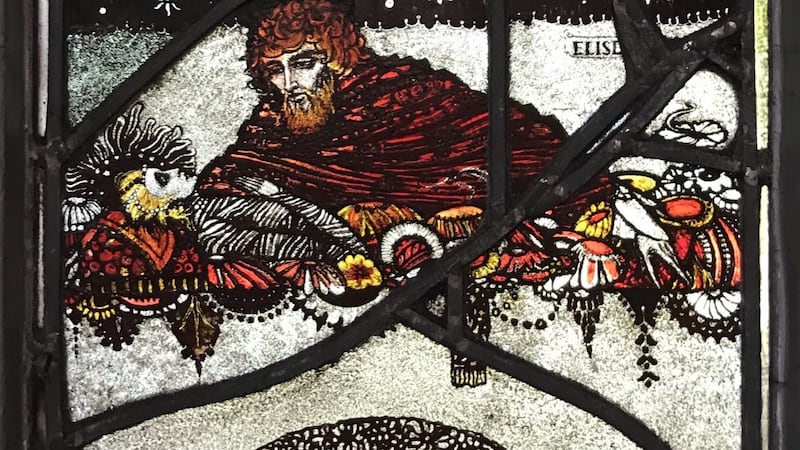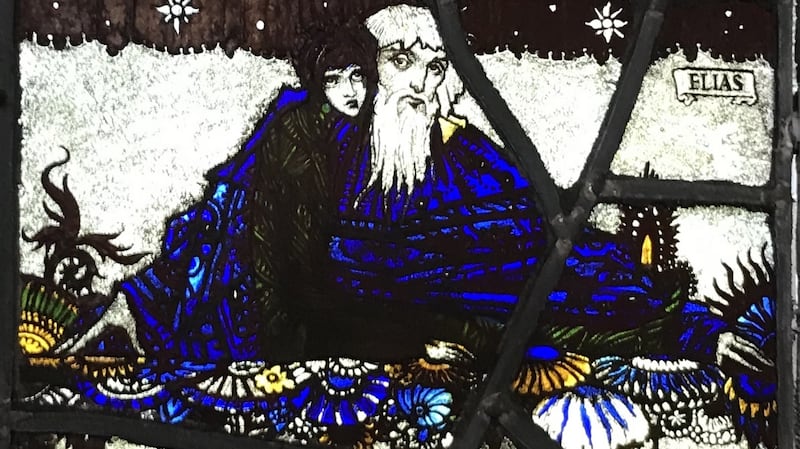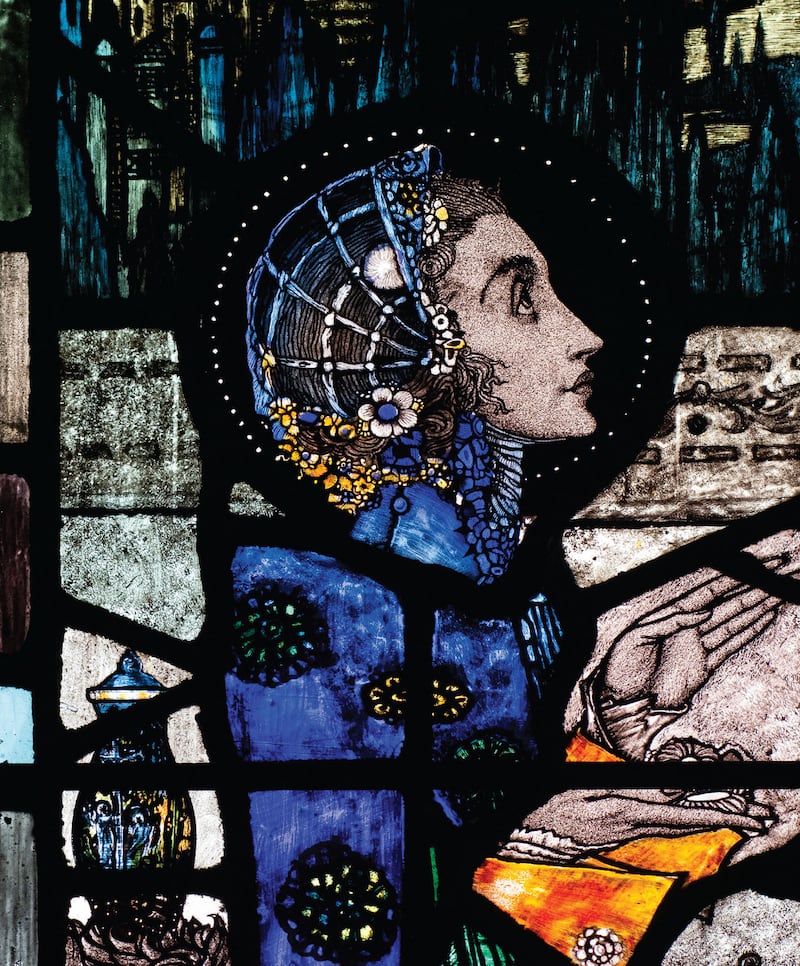At the start of lockdown I couldn’t write and I found reading fiction impossible. I had a pile of books to review but each time I opened one I’d get a few paragraphs in and my mind would return to its default setting – something between numbed idleness and dread: I felt like my ancient MacBook, unable to do two tasks at the same time without crashing.
One book in the pile was different from my usual diet of literary fiction: Dark Beauty: Hidden Detail in Harry Clarke's Stained Glass by Lucy Costigan and Michael Cullen (Merrion Press).
Flicking through this luscious, illustrated hardback, I found dazzling geometry, languid eyes, fabled animals and demonic faces in a glory of colour: purple and crimson; canary and turquoise; midnight blue. The intensity and intricacy of flowers brought me Rosetti’s poem, A Birthday, yet alongside this was a sense of the uncanny; Clarke’s depictions have something of the fairy tale, the old kind where there is something malevolent in a pair of red dancing shoes.

The research in Dark Beauty is scholarly and thorough with an engaging passion and intimacy, examining the smaller sections in Clarke's windows, minute details which are often overlooked; it's as much for the Harry Clarke expert as for people like me, who know a fraction about the artist but are drawn to beautiful, dark things, with a touch of magic.
I was first introduced to Harry Clarke by a friend; we were walking past John’s Lane Church on a busy Thomas Street on the way to her studio, something which feels like another lifetime now. There you can find work not by the artist himself, but by Harry Clarke Studios which he set up in 1930, a year before he died of tuberculosis at the age of 41.
Like many of us I’d had a coffee or two surrounded by the six decorative windows in Bewley’s cafe on Grafton Street; I leafed through the images to find that those overlooking Swan Lane contain some of the best examples of Clarke’s imagination, with delicate butterflies, exotic birds, sea creatures, all in riotous beauty: what is to become of them now?

One of his most celebrated pieces, The Eve of St Agnes, is in The Hugh Lane, now illuminating a quiet and unobserved gallery. I looked at Clarke’s exquisite imagining of Keats’s famous poem, then migrated from the book to the old laptop, looking up half-forgotten stanzas, remembering my melodramatic teenage self. I was reading again, if only in tiny sustaining morsels: since Clarke’s panels told a story, perhaps if I couldn’t write, I would take pictures.
When I feel stuck, taking pictures is nourishing; I love analogue photography, its mortality, how colour can bleed and blur, most of all the element of chance. I wanted to see how Clarke’s colours might develop this way – it felt fitting for the subject of light through glass.
I scanned the index, curious as to where other windows might be located, places that might open again in June, July, August. I hadn’t hoped to find two churches within five kilometres, both with Harry Clarke originals – one in Lusk, and one in Balbriggan, Co Dublin.

I went to Lusk on a day with gale force winds, sprawling showers interspersed with May sunshine. This was appropriate for the window I’d read about, Clarke’s Memorial Lancet of St Maculind (1924), the saint from whom the church takes its name, one in which his famous motif of darkness and light is clear. Here are the outsiders of society, the poor, the sick, gathered around Maculind. At that time in conservative Ireland, this was revolutionary – Clarke’s depiction of marginalised people suggested everyone was equal in the eyes of God, implying the same should hold for society: a pertinent message. Perhaps this would be my story; I was beginning to think in narrative again.
But the day turned sour and overcast. I knew before I reached the locked door that the church was closed. I walked around the perimeter, flanked by the graveyard, looking upwards at the 11th century round tower, intact through epidemics, wars, and famine. I tried to picture the hands of the man who made the glass, the people who installed the windows, the first eyes that saw the light stream in over 100 years ago.
Even though I grappled with the metaphor of looking from the outside in, having spent two months on the inside looking out, there was no colour or magic in the back-to-front glass, the story was inaccessible: if anything it felt like a grey essay on lockdown.
I wasn’t optimistic about seeing much in Balbriggan – if one church was closed, surely they all would be. But when I got there, the doors were open. I asked the priest for permission to take pictures; he was gracious, but the bowed heads of people sitting metres apart on different pews made me feel an intruder. The aisles had been sealed off; I had to walk past Jesus once, twice, three times to capture the Harry Clarke windows, each on different sides of the altar. Every time I pressed the shutter it sounded like I’d fired a pistol. I swapped analogue for digital, unwilling to puncture the silence further.

I focused on the small moments: in The Visitation (1924), I was drawn to Mary’s face, to the tiny, staggeringly detailed flowers on her translucent veil, to the bloom of light at that moment on her face; in The Widow’s Son (1924) I concentrated on two small lower panels both depicting Eliseus bringing a figure back to life.
It sparked questions: would you want to be revived from death? What is worth rekindling in ourselves and what is better left in peace? My curiosity grew about the story in those panels, who the figure on the bed was based on, who the Marcella Rogers was for whose soul we are asked to pray and what kind of life she led, if Harry Clarke had believed any of what he made transpire in glass. And as the saying goes, curiosity is the beginning of desire – in my case, the desire to write something.
I sat for a while before I left. I didn’t pray, but looking up into those colours, refracted by light, it felt not unlike prayer, a feeling of gratitude perhaps, or maybe more a sense of relief – for hidden beauty, unexpected joy, small miracles.
Dark Beauty: Hidden Detail in Harry Clarke’s Stained Glass by Lucy Costigan and Michael Cullen (full colour, 300+ images). Merrion Press, €35.00










